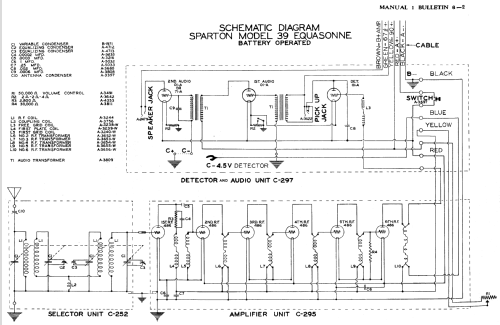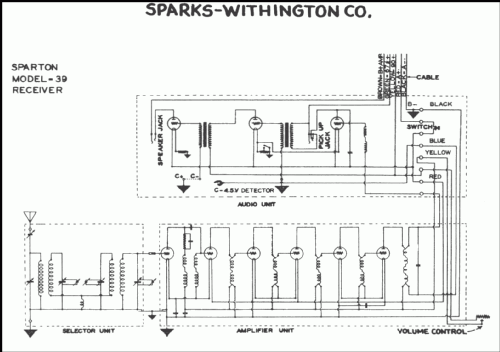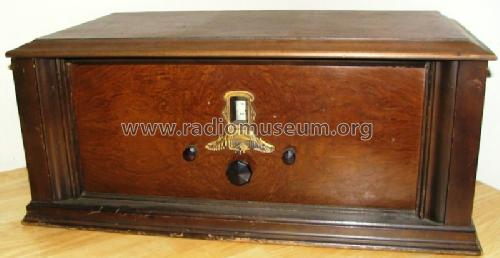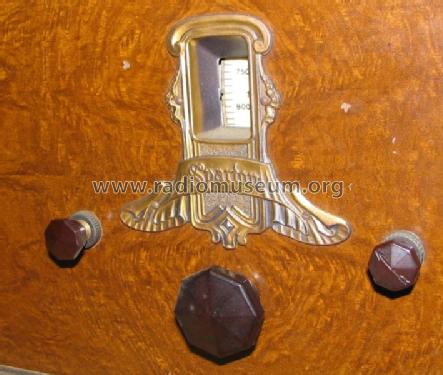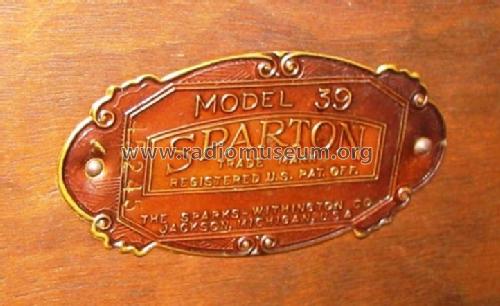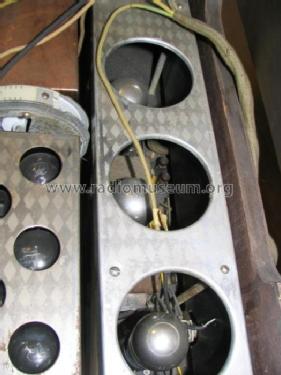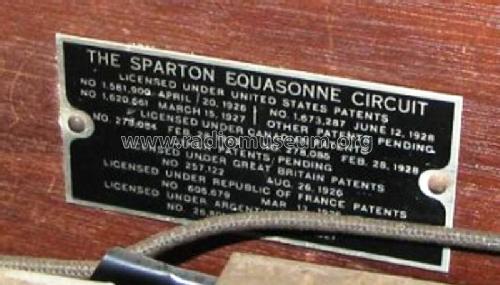Sparton 39 Equasonne
Sparks-Withington Co., (Sparton); Jackson, Michigan
- Pays
- Etats-Unis
- Fabricant / Marque
- Sparks-Withington Co., (Sparton); Jackson, Michigan
- Année
- 1928/1929

- Catégorie
- Radio - ou tuner d'après la guerre 1939-45
- Radiomuseum.org ID
- 58604
Cliquez sur la vignette du schéma pour le demander en tant que document gratuit.
- No. de tubes
- 9
- Principe général
- Récepteur TRF - sans réaction (pas régénératif); 3 Etage(s) BF
- Circuits accordés
- 4 Circuits MA (AM)
- Gammes d'ondes
- PO uniquement
- Tension / type courant
- Piles (rechargeables ou/et sèches)
- Haut-parleur
- - Pour casque ou amplificateur BF
- Matière
- Boitier en bois
- De Radiomuseum.org
- Modèle: Sparton 39 Equasonne - Sparks-Withington Co., Sparton
- Forme
- Modèle de table boitier avec vouvercle
- Dimensions (LHP)
- 610 x 267 x 318 mm / 24 x 10.5 x 12.5 inch
- Remarques
-
The Sparton model 39 has one dial (primary tuning control knob). The models 39, 69, 79-A, 89, 89-A, 99, 109 and 930 are the first "Equasonne" models. The tubes are the original line up, not replacement, according to the page "The quantity and types of tubes used in Sparton receiving sets" and of Rider's page Sparton 5-6, displacement would be the tube 486. The model 39 and (later) model 49 share the same tubes (and schematic).
See also the article here about different radio seasons.The history to the Equasonne line: In February 1928 RCA sued Sparks-Withington for using the Alexanderson TRF patent. After that, Sparton began using a circuit not covered by that patent, a circuit invented by Lester Jones (Technidyne Corp.). A tube with tightly controlled grid-to-plate capacitances was needed and Sparton-Cardon created the type 484, 485 and 486 and produced them too. Before, Sparton used Kellogg tubes. The Equasonne is a two chassis construction. The RF chassis with 6 tubes used (also?) a phenolic board, not metal. The trick is a 4-circuit pre-selector followed by a broadband amplifier system. Then follows the audio unit with a power-detector (plate detector) with a very high value cathode resistor for a non-linear detector which amplifies.
The next season followed the Equasonne models 49, 101, 110, 111, 111-A, 301, 301-DC, 931 and 931-DC. The last Equasonne appeared in 1930/31 as models 103, 235, 564, 570, 574, 589, 591, 593, 600, 600-DC, 610, 610-DC, 620, 620-DC, 737, 740, 740-DC, 750, 750-DC, 870.
- Source extérieure
- Ernst Erb
- Source du schéma
- Rider's Perpetual, Volume 1 = 1931/1934 (for 1919-1931)
- Schémathèque (1)
- Sparton Radio Service Manual (Sparton Manual 1, Bulletin 6-1,2,3,4)
- D'autres Modèles
-
Vous pourrez trouver sous ce lien 836 modèles d'appareils, 374 avec des images et 782 avec des schémas.
Tous les appareils de Sparks-Withington Co., (Sparton); Jackson, Michigan
